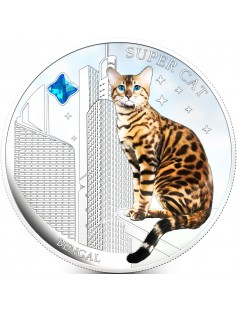- Low mintage limit, only 5,000
- Coin in capsule + with Certificate of Authenticity + BOX
- Second coin in Super Cat series
- Coin not issued yet. Be Firt who will get it
- First coin with NEW FIJI reserve design.
- Coin with Swarovski crystal
The Bengal
The Bengal is a hybrid breed of cat, formed by the cross of a domestic feline and an Asian leopard cat (ALC), Prionailurus bengalensis bengalensis.The Bengal cat has a desirable "wild" appearance with large spots, rosettes, and a light/white belly, and a body structure reminiscent of the ALC. The Bengal possesses a gentle domestic cat temperament, provided it is separated by at least three generations from the original crossing between a domestic feline and an ALC.
Appearance
Bengal cats have "wild-looking" markings, such as large spots, rosettes, and a light/white belly, and a body structure reminiscent of the leopard cat. A Bengal's rosetted spots occur only on the back and sides, with stripes elsewhere. The breed typically also features "mascara" (horizontal striping alongside the eyes), and foreleg striping. The Bengal cat is usually either classed as brown-spotted or snow-spotted (although there are more colours, brown and snow are the only colours of Bengal that the Governing Council of the Cat Fancy (UK) recognize). Within brown Bengals, there are either marble or spotted markings. Included in the spotted variation is rosetted, which consists of a spot with a dark line surrounding it. Snow Bengals are also either marble or spotted, but are also divided into blue-eyed or Any Other Colour eyes. The International Cat Association recognizes several Bengal colours (brown, seal lynx point, mink, sepia, silver) and patterns (spotted and marbled) for competition. In the New Traits class, other colours may be shown, as well as longhairs.
Temperament
A?er three generations from the original crossing, the breed usually acquires a gentle domestic cat temperament; however, for the typical pet owner, a Bengal cat kept as a pet should be at least four generations (F4) removed from the leopard cat. The so-called "foundation cats" from the first three filial generations of breeding (F1–F3) are usually reserved for breeding purposes or the specialty pet home environment.








